|
|
|
Sort Order |
|
|
|
Items / Page
|
|
|
|
|
|
|
| Srl | Item |
| 1 |
ID:
132133
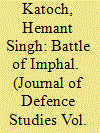

|
|
|
|
|
| Publication |
2014.
|
| Summary/Abstract |
The year 2014 is the 70th anniversary of the Battle of Imphal. To mark the occasion, this article looks at who fought it; how and where the fighting unfolded in Manipur; how it was a battle fought in the air as well; and the link with the INA and the Chindits. It also notes the many reminders of the Second World War in Manipur today and concludes with a brief overview of the state's overall experience of the war. The article aims, in effect, to introduce the reader to the Battle of Imphal, an extraordinary event in India's history that has received little to no attention till date.
|
|
|
|
|
|
|
|
|
|
|
|
|
|
|
|
| 2 |
ID:
132129
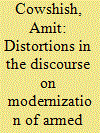

|
|
|
|
|
| Publication |
2014.
|
| Summary/Abstract |
The strategic discourse on defence and security matters in India revolves around familiar themes and sub-themes, ranging from larger issues such as the absence of a clearly articulated national security policy to somewhat fractious issues such as the higher defence management, civil-military relations and modernization of the armed forces.
|
|
|
|
|
|
|
|
|
|
|
|
|
|
|
|
| 3 |
ID:
132131
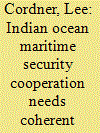

|
|
|
|
|
| Publication |
2014.
|
| Summary/Abstract |
Maritime security in the Indian Ocean Region (IOR) is a central issue for regional and extra-regional actors. Traditional and non-traditional security challenges largely converge at sea as they impact economic, environmental, energy, human, food and national security. As the major regional power and an emerging Asian great power, India's willingness and capacity to provide strategic leadership is critical to engendering a cooperative spirit of shared destiny. India's growing naval capabilities indicate a strong commitment to maritime security. However, its strategic policy ambiguity and lack of transparency undermines trust and confidence. Allegations of civil-military dissonance and the lack of political will for reform raises questions about strategic competence. India's willingness and capacity for cooperative regional security leadership presents regional risks. The new Indian government is presented with significant challenges to reform domestic politico-bureaucratic-military arrangements in order to enhance external and internal consistency and credibility, and improve openness and coherency.
|
|
|
|
|
|
|
|
|
|
|
|
|
|
|
|
| 4 |
ID:
132130
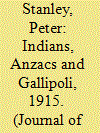

|
|
|
|
|
| Publication |
2014.
|
| Summary/Abstract |
As one of the world's most populous nations, India today has one of its largest armies, which stands ready to defend the nation. A century ago, India's army was similarly large but was used to defend the British empire as well as Britain's Indian possessions. In 1914, the Indian Army (a force of about 200,000 men) provided a vast reservoir of trained military manpower, one immediately used by Britain as it entered the Great War. In the war's earliest weeks, from August 1914, the Indian Army was mobilised for service, and within months the first Indian troops saw service against imperial Germany, in East Africa, but also on the Western Front in France and Belgium.
|
|
|
|
|
|
|
|
|
|
|
|
|
|
|
|
| 5 |
ID:
132132
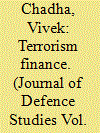

|
|
|
|
|
| Publication |
2014.
|
| Summary/Abstract |
Terrorism finance (TF) has been termed as the life blood of terrorism, one of the most important factors sustaining its continuing threat, both from within and without. In the West, a large body of work on the subject appeared after 9/11; in the Indian context, however, there is little contribution towards existing literature. This article contextualizes the reality of terrorism finance in India and provides an alternative framework for a better understanding of this threat. It analyses both the external and internal sources of terror finance and emerging trends in the country in order to provide a better understanding of the nature of threat, as a prelude to countering it at the policy formulation level. It also reinforces the findings through a case study of the United National Liberation Front, a terrorist group in North-East India.
|
|
|
|
|
|
|
|
|
|
|
|
|
|
|
|
|
|
|
|
|